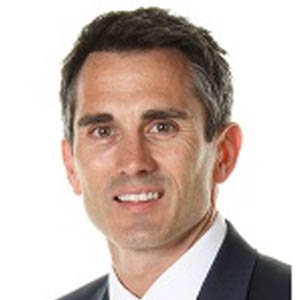Banks are using new technologies to help corporate clients make better financial decisions.

As head of product innovation and disbursements, global payments, at Bank of America Merrill Lynch, Matthew Leavenworth thinks about how new technologies can make the world of business payments more efficient and cost-effective. But having spent time at Amazon as part of its global payments team before joining BofA Merrill in 2010, Leavenworth does not think about corporate payments—checks, Automated Clearing House (ACH) and disbursements—in quite the same way that many of his peers do.
Leavenworth wants to bridge the gap between how we experience digital technologies as consumers and our experience of them in the corporate realm. So just as mobile apps like Uber make it easy for consumers to find a taxi no matter what their location, and streaming music services like Spotify enable you to access your playlist on any mobile device anytime, anywhere, Leavenworth says digital corporate banking should also provide treasurers with the same ease of use, access and flexibility.
He has his work cut out for him, though—corporate digital banking, online music streaming and mobile cab apps are worlds apart. Although Uber and Spotify can seamlessly push out information to mobile devices whenever and wherever a consumer taps a screen, corporate cash management banks are still grappling with providing useful and timely transaction-related information across multiple digital devices.
As consulting and outsourcing solutions provider CSC and Finextra Research recently pointed out in a survey they conducted of CIOs, COOs and heads of digital banking from more than 50 financial institutions, “banks find it difficult to transform valuable information about individuals into revenue-generating opportunities.”
Yet Leavenworth believes anything is possible if new digital banking applications are packaged as Web services—machine-to-machine communications via the Web using open standards. Just as mobile apps like Uber represent a new way of thinking about distribution— the customer no longer has to contact the cab company’s call center directly to order a cab but can merely tap an icon on the screen of a mobile device—banks, Leavenworth says, could use Web services to push out account and transaction-related information that helps corporates make faster and more well-informed financial decisions.
We don’t want Apple…to own the customer.
~ Hemant Gada, Citi
“I’m not saying I want to invent teleportation,” he says. “We just need to move things a step forward.” A good example is BofA Merrill’s Digital Disbursements solution, which uses either a mobile-phone number or email address for B2C payments. Geared toward large corporate, middle-market and public-sector clients, the solution takes advantage of the bank’s investment in the clearXchange peer-to-peer (P2P) payments platform.
When it comes to adopting digital banking technologies, the consumer bank may be far ahead of its more conservative corporate counterpart. However, the pace of innovation in the payments space alone is forcing corporates to rethink their views on digital banking, says Adam Rowse, head of business banking at UK bank Barclays. “As a result of newer forms of payment like Apple Pay, Pingit (Barclays mobile-payment service) and PayPal, we’re sitting down with corporates and asking them, ‘How can we help you through that payments landscape that’s evolving so quickly?’ For some corporate customers who were initially skeptical of digital banking, showing them how they can have full control over their accounts has transformed the way that they bank.”
In addition to mobile payments, existing forms of payment such as checks, Rowse says, are also being digitized. Barclays is testing a scanning solution for digitizing large volumes of checks with its corporate clients, as well as solutions that will enable small and medium-size companies to order cash using a digital app instead of having to visit a branch. Barclays also sells Cloud storage—under the brand name Cloud IT—to personal and business banking customers for storing personal documents and bank statements. The bank plans to extend the solution to its corporate customer base. “Cloud IT is an easier way for customers to manage their business,” says Rowse, “and ultimately, where we see this going is, [it will help] us link the invoice [in the Cloud] with the payment.”

Consumer digital banking applications may have spilled over into corporate banking, however. Hemant Gada, head of channels and enterprise services, EMEA, at Citi, says there are still some key differences between corporate and retail digital banking. Digital banking may be purely about convenience for consumers, but for corporates, says Gada, it is more about delivering greater levels of automation and efficiency.
Corporate customers are not interested in digitizing just the transaction but also the information that accompanies it, so as to aid matching and reconciliation of payments with invoices and gain greater control and visibility over cash balances. Doing so, in turn, can help with cash forecasting and liquidity management.
Gada says Citi is able to offer corporates greater visibility into their cash and liquidity across all their accounts globally. And by better understanding a client’s ecosystem and payment flows, the bank is able to be more proactive and predictive in terms of how and when it inserts itself at different points in the transaction value chain, thereby offering working capital solutions—such as supply chain financing—that better meet the client’s needs. This information, says Gada, is presented in an easily digestible form via the bank’s online banking channels, including tablet.
However, an elegant, digital front end cannot disguise the fact that there is still considerable work to do on the back end of most banks’ legacy infrastructure. “As a bank, we’ve been around for 325 years, and sometimes the systems feel that old,” says Rowse of Barclays, adding that the aim is to build new things as opposed to just upgrading old systems. Rowse says the pace of innovation in the corporate digital banking space is mostly about the message coming from senior management. “Ashok Vaswani, [CEO of personal and corporate banking] is passionate about digital banking,” says Rowse, “as it makes everything instantly more transparent to customers—and life much easier right across the spectrum.”
Although banks may not be able to innovate as quickly as Internet natives like Google or Apple, Citi has embraced the digital mind-set, says Gada. “We consult clients much earlier in the product development process, trying to understand the user experience they desire, prototype it and then develop it.”

With new, digital solutions emerging all the time, the biggest challenge for the banks, says Gada, is deciding which horse to back in the race. “Take digital security, for example,” he says. “Barclays launched finger vein technology for authentication. Do we rally behind that? Do we look at some of the gadgets coming out, such as Apple Watch? There’s an immense amount of choice out there, but there’s no real clear winner.” Citi has signed up to be a banking provider to Apple’s mobile-payment solution, Apple Pay, and recently became one of the first banks to design an app for Apple’s smartwatch. But as Gada points out: “We don’t want to become just a utility—or for Apple to necessarily own the customer.”
Virtual currency is also relatively unexplored by commercial banks, yet it may help mitigate currency exchange risk. “It may still be conjecture at this point,” says Gada, “but as these currencies gain more liquidity and the appropriate regulatory oversight, they could become a transport mechanism cross-border that corporates can add to their armory in terms of risk mitigation.” Some banks are also contemplating a future where the human touch in corporate banking could diminish altogether. “Today, there is a lot of human intervention in day-to-day transaction processing within clients and banks,” says Gada. “But through the use of data and analytics, we could expect that predictive payments with little or no human touch become the norm.”



